
34 Số 6/2024
NGHIÊN CỨU
HIỆN TRẠNG RÁC THẢI NHỰA Ở KHU VỰC CỬA SÔNG SÀI GÒN -
ĐỒNG NAI VÀ CÁC GIẢI PHÁP QUẢN LÝ
PHẠM DUY THANH1,2, NGUYỄN XUÂN HOÀN1
1Khoa Sinh học và Môi trường, Trường Đại học Công Thương TP. Hồ Chí Minh
2Viện Môi trường và Tài nguyên TP. Hồ Chí Minh
Tóm tắt:
Khu vực cửa sông Sài Gòn - Đồng Nai có mật độ dân cư cao, cùng với quá trình đô thị hóa mạnh, làm tăng
việc phát sinh rác thải nhựa (RTN). Nghiên cứu này có mục tiêu khảo sát, phân tích khối lượng, số lượng
mảnh nhựa và nồng độ kim loại nặng Cr, Pb, Zn, Cd trong RTN tại khu vực cửa sông Sài Gòn - Đồng Nai.
Các phương pháp sử dụng bao gồm: Thu mẫu, phân tích RTN, phân tích kim loại nặng, xử lý số liệu. Kết
quả nghiên cứu cho thấy, RTN xuất hiện tại tất cả 6 điểm khảo sát, khối lượng có giá trị trung bình 5,29
mg/m3; các mẫu nhựa có chứa kẽm, crôm và chì; hàm lượng kẽm có giá trị cao nhất, đạt 50,7 mg/kg, tiếp
theo là crôm và chì, ứng với giá trị lần lượt là 14,1 mg/kg và 9,8 mg/kg. Một số giải pháp quản lý RTN khu
vực cửa sông Sài Gòn - Đồng Nai đã được đề xuất, bao gồm: Thu gom RTN phát sinh từ hoạt động nuôi
trồng, đánh bắt thủy, hải sản (bãi nuôi hàu, ngao), cánh đồng muối, khu vực dân cư; giảm thiểu nhựa sử
dụng một lần, tăng cường tái chế, tái sử dụng RTN; định kỳ thực hiện các chiến dịch làm sạch RTN phát
sinh trong khu vực; ngăn ngừa RTN phát sinh từ các khu du lịch, nhà nghỉ ven sông trong khu vực, RTN
từ hoạt động vui chơi, giải trí trên bãi biển, hướng tới phát triển du lịch không RTN; áp dụng hiệu quả các
công cụ quản lý RTN (chính sách pháp luật, công cụ kinh tế, công nghệ kỹ thuật và giáo dục) trên phạm
vi toàn quốc.
Từ khóa: Kim loại nặng, khu vực cửa sông, RTN lớn.
Ngày nhận: 10/5/2024; Ngày sửa chữa: 6/6/2024; Ngày duyệt đăng: 19/6/2024.
Macroplastics in the Saigon - Dong Nai estuary
and solutions for managing plastic waste
Abstract:
Rivers are a major pathway for plastic transport into the seas and plastic waste is often concentrated in the
estuary. This region frequently experiences high population density and robust urbanization, which increases
the generation of plastic waste. This research aimed to analyze macroplastic (> 5 mm) in the Saigon-Dong
Nai estuary, investigating mass characteristics, the number of plastic fragments, and concentrations of heavy
metals (Cr, Pb, Zn, Cd). This study employed various methods, including sampling and analyzing macroplastic
characteristics, measuring heavy metal concentrations, and conducting statistical analyses. The results of the
study showed that there was plastic waste at all six sites, with an average value of 5.29 mg/m3, plastic waste
contained zinc, chromium, and lead; the zinc content had the highest value, reaching 50.7 mg/kg; followed
by chromium and lead with values of 14.1 mg/kg and 9.8 mg/kg, respectively. Several solutions to manage
plastic waste in the Saigon - Dong Nai estuary area have been proposed, including: Collection of plastic waste
arising from aquaculture and fishing activities (oyster and clam farms), salt fields, residential areas; reduce
single-use plastics, increase recycling and reuse of plastic waste; periodically implement campaigns to clean
up plastic waste generated in the area; prevent plastic waste arising from tourist resorts, riverside motels in
the area, plastic waste from entertainment activities on the beach, towards the development of plastic waste-
free tourism; effectively apply plastic waste management tools (environmental law and policy, economic policy
instruments for plastic waste, technology solutions and education) nationwide.
Keywords: Heavy metal, estuary, macroplastic.
JEL Classifications: Q51, O44, R11, P18, Q53.

35
Số 6/2024
NGHIÊN CỨU
1. ĐẶT VẤN ĐỀ
Ngày nay, nhựa đã trở thành một phần thiết yếu trong
cuộc sống hàng ngày của con người, chúng được sử dụng
trong nhiều lĩnh vực khác nhau (Rillig, 2012). Do thời gian
phân hủy lâu, RTN tồn tại trong môi trường nhiều năm
(Allen et al., 1988) sẽ gây ra những tác động không tốt đến
hệ sinh thái (HST), sinh vật và con người. Dưới tác động
của các yếu tố môi trường, RTN lớn bị vỡ vụn thành những
mảnh với kích thước nhỏ, có thể gây ra một số mối đe
dọa, tác động đến các loài sinh vật biển như mắc kẹt trong
đường tiêu hóa, gây ngạt thở (Boren et al., 2006). Bên cạnh
đó, RTN cũng có thể là nguyên nhân gây ô nhiễm hữu cơ
cho sinh vật vì các chất ô nhiễm bao gồm hydrocacbon
thơm đa vòng (PAHs: polycyclic aromatic hydrocarbons);
dichlorodiphenyltrichloroethane (DDT) và polychlorinated
hydrocarbons (PCBs) có xu hướng tích tụ trên bề mặt nhựa
(Ogata et al., 2009). Ngoài ra, sự hấp phụ của kim loại nặng
trên nhựa cũng đặt ra vấn đề đáng lo ngại ở khía cạnh môi
trường (Weijuan, et al., 2001).
Dòng sông là con đường chính vận chuyển rác từ đất
liền ra biển và khu vực cửa sông là nơi tiếp nhận, tập trung
RTN (Schmidt et al., 2017), tuy nhiên, khu vực này thường
có mật độ dân cư cao và quá trình đô thị hóa làm tăng việc
phát sinh RTN (Damar & Hariyadi, 2022). Emmerik và cs.,
2018 đã thực hiện quan trắc RTN tại điểm cầu Thủ Thiêm,
sông Sài Gòn để tính lượng rác đổ ra biển. Kết quả nghiên
cứu cho thấy, lượng RTN phát thải theo dòng sông Sài Gòn
ra biển Đông ước đạt 7,5 x 103 - 13,7 x 103 tấn/năm (Van
Emmerik et al., 2018).
Nghiên cứu này có mục tiêu xác định nồng độ RTN
trong môi trường nước và phân tích hàm lượng kim loại
nặng trong RTN tại khu vực cửa sông Sài Gòn - Đồng Nai.
Theo đó, nghiên cứu thực hiện thu mẫu RTN lớn (> 5 mm)
tại khu vực cửa sông Sài Gòn - Đồng Nai nhằm xác định
đặc điểm về khối lượng, số lượng mảnh nhựa, nồng độ kim
loại nặng Cr, Pb, Zn, Cd trong RTN.
2. ĐỊA ĐIỂM VÀ PHƯƠNG PHÁP NGHIÊN CỨU
2.1. Vị trí, thời gian thu mẫu
HST vùng cửa sông là môi trường sống của nhiều
loài sinh vật, có độ đa dạng cao và dễ bị tác động bởi sự ô
nhiễm. Nghiên cứu này thực hiện thu mẫu RTN tại 6 điểm
thuộc khu vực cửa sông Sài Gòn - Đồng Nai. 4 điểm S2, S3,
S4, S6 tương ứng là vị trí cửa sông Lòng Tàu, sông Đồng
Đình, sông Đồng Tranh và sông Soài Rạp; điểm S1 thuộc
sông Lòng Tàu, gần cửa sông Sài Gòn và điểm S5 trên sông
Lò Rèn, trong rừng ngập mặn. Vị trí thu mẫu được thể hiện
trong Hình 1; các mẫu được thu trong tháng 11/2023.
2.2. Phương pháp nghiên cứu
2.1. Phương pháp thu mẫu
Để thu mẫu RTN trong nước, nhiều phương pháp có
thể được sử dụng, bao gồm: Quan sát trực tiếp; sử dụng
lưới; dùng hệ thống phao; ứng dụng cảm biến; quay phim;
dùng máy bay không người lái hoặc sử dụng vệ tinh (Van
Emmerik & Schwarz, 2020) (Lippiatt, et al., 2013). Nghiên
cứu sử dụng lưới để thu mẫu RTN có kích thước > 5 mm
(macroplastic) trên sông; lưu tốc dòng được đo bằng thiết
bị Flowatch, Thụy Sĩ; khung lưới có kích thước 0,7 x 0,6 m,
mắt lưới 5 mm.
Tại mỗi điểm, nghiên cứu thực hiện thu 3 mẫu, 2 mẫu
ở hai bờ và 1 mẫu giữa dòng sông. Ngoại trừ điểm S2 (cửa
sông Lòng Tàu) không thu mẫu giữa dòng vì lý do an toàn,
bởi tại đây nhiều tàu lớn di chuyển, gây nguy hiểm khi thu
mẫu. Thời gian kéo lưới thu mẫu là 15 phút (GES, 2016).
VHình 1. Vị trí thu mẫu
Thu mẫu RTN Đo lưu tốc dòng nước
VHình 2. Thu mẫu RTN trên sông
2.2. Phương pháp phân tích RTN
Mẫu RTN được rửa sạch, phơi khô, sau đó đếm số
mảnh, đo kích thước và cân khối lượng. Cân 4 số (Ohaus
PR 224) được dùng để cân khối lượng RTN. Kích thước
RTN là kích thước lớn nhất của mảnh rác thu được, được
tính bằng phần mềm Image J.
Từ thời gian thu mẫu và diện tích lưới, tính ra thể tích
nước được lọc qua lưới. Nồng độ RTN (C) được tính cho 1
m3 nước theo công thức sau:
C = n/V (RTN/m3)
Trong đó: n là số RTN thu được; V là thể tích nước
(m3) được lọc qua lưới (Lippiatt et al., 2013).

36 Số 6/2024
NGHIÊN CỨU
2.3. Phương pháp phân tích kim loại nặng
Để phân tích kim loại nặng trong nhựa, nghiên cứu này
chọn 3 loại vật dụng từ mẫu RTN thu được, gồm mảnh xốp,
màng nhựa và sợi nhựa. Nghiên cứu thực hiện phân tích
các kim loại nặng Cd, Cr, Pb, Zn trong RTN theo phương
pháp phổ khối - plasma kết hợp cảm ứng (Inductively
coupled plasma - mass spectrometry: ICP - MS). Các mẫu
được phân tích tại Trung tâm dịch vụ phân tích thí nghiệm,
phường Đa Kao, quận 1, TP. Hồ Chí Minh (CASE).
2.4. Xử lý số liệu
Số liệu được xử lý bằng phần mềm Microsofl Excel
Office 2010 và SPSS Version 22.0.0.0. Sử dụng phương pháp
phân tích ANOVA để so sánh giá trị trung bình mẫu ở các
điểm với độ tin cậy 95%. Phần mềm AcrMap 10.8 được dùng
để thể hiện vị trí và kết quả tại các điểm thu mẫu.
3. KẾT QUẢ VÀ THẢO LUẬN
3.1. RTN trong nước
Kết quả phân tích chỉ ra rằng, khối lượng RTN tại các
điểm thu mẫu có giá trị dao động từ 0,39 mg/m3 (Điểm S5)
đến 10,12 mg/m3 (Điểm S4). Trung bình khối lượng RTN
tại 6 điểm có giá trị 5,29 mg/m3. Kết quả phân tích thống
kê cho thấy có sự khác nhau về khối lượng rác tại mỗi điểm
(Pvalue < 0,05) (Bảng 1).
Số mảnh RTN trong nước tại các điểm trung bình có
giá trị 0,73 mảnh/m3. Điểm S4, cửa sông Đồng Tranh có
giá trị cao nhất là 1,55 mảnh/m3, trong khi đó, điểm S5 có
giá trị thấp nhất, đạt 0,01 mảnh/m3. Cũng giống như khối
lượng RTN, có sự khác nhau về số mảnh nhựa tại các điểm
khảo sát (Pvalue <0,05).
Bảng 1. Kết quả RTN tại các điểm
Điểm thu
mẫu
Khối lượng
RTN
(mg/m3)
Số mảnh
nhựa
(mảnh/m3)
Kích thước
RTN
(cm)
Ghi chú
S1 5,89 ± 2,11 0,55 ± 0,07 8,06 ± 1,50 Sông Lòng Tàu, gần sông Sài Gòn
S2 6,98 ± 3,79 0,29 ± 0,22 5,66 ± 2,57 Cửa sông Lòng Tàu
S3 3,30 ± 1,93 1,08 ± 0,43 5,40 ± 0,20 Cửa sông Đồng Đình
S4 10,12 ± 4,00 1,55 ± 0,41 8,97 ± 3,42 Cửa sông Đồng Tranh
S5 0,39 ± 0,02 0,01 ± 0,01 7,83 ± 4,95 Sông Lò Rèn, trong rừng ngập mặn
S6 5,05 ± 1,83 0,90 ± 0,10 7,83 ± 1,91 Cửa sông Soài Rạp
Trung bình
± Độ lệch
chuẩn
5,29 ± 3,30 0,73 ± 0,56 7,21 ± 1,79
Giá trị trung bình kích thước RTN tại 6 điểm khảo sát
có giá trị là 7,21 cm. Kết quả phân tích thống kê chỉ ra rằng
không có sự khác biệt về kích thước RTN tại các điểm khảo
sát với độ tin cậy là 95% (Pvalue > 0,05).
Một cách trực quan, khối lượng RTN tại mỗi điểm
được thể hiện bằng biểu đồ cột trong Hình 3.
Để khảo sát RTN nổi trên sông, có thể dùng phương
pháp quan sát trực tiếp hoặc dùng lưới thu mẫu (Van
Emmerik & Schwarz, 2020) (Lippiatt, et al., 2013) (GES,
2016). Lượng RTN được biểu thị bằng các đơn vị tương
ứng với phương pháp sử dụng. Bảng 2 trình bày kết quả của
các nghiên cứu về RTN trên sông. So với kết quả nghiên
cứu của Haberstroh và cs., 2021 trên sông Hillsborogh
nước Mỹ thì khối lượng RTN ở khu vực cửa sông Sài Gòn
- Đồng Nai cao hơn gấp 2,41 lần (Haberstroh et al. 2021).
VHình 3. RTN tại các điểm khảo sát
(a) RTN (b) Khối lượng RTN tại các điểm
Bảng 2. Kết quả khảo sát RTN lớn ở một số sông
trên thế giới
Khu vực RTN Phương pháp Ghi chú Nguồn
Sông Klang,
Malaysia
200 - 10.000 mảnh/
giờ
Đếm rác bằng phần
mềm CrowdWater
Mặt nước
(Van Emmerik
et al., 2020)
Sông Orange -
Vaal, Nam Phi 0,8 ± 2,9 mg/m2 Quan sát trực tiếp
trên cầu
Mặt nước (Weideman, et
al., 2020)
Sông Hillsborogh,
USA
2,36 mg/m3Dùng lưới thu mẫu Mặt nước (Haberstroh et
al., 2021)
0,34 mg/m3 Dùng lưới thu mẫu Cột nước
Sông Sài Gòn
-Đồng Nai 5,29 mg/m3Dùng lưới thu mẫu Mặt nước Kết quả của
nghiên cứu
Emmerik và cs., 2018 đã thực hiện quan trắc RTN tại
điểm cầu Thủ Thiêm, sông Sài Gòn để tính tổng lượng
rác đổ ra biển Đông (Van Emmerik et al., 2018). Trong
khi đó, nghiên cứu này cung cấp thông tin về nồng độ
RTN trong nước (mg/m3) ở khu vực cửa sông Sài Gòn
- Đồng Nai.
Nhìn chung, khu vực cửa sông Soài Rạp (S6), sông
Lòng Tàu (S2), sông Đồng Tranh (S4) có khối lượng RTN
cao hơn điểm ở khu vực phía thượng nguồn (S1 gần cửa
sông Sài Gòn) và điểm trong rừng ngập mặn (S5). Dòng
sông là con đường chính vận chuyển rác từ đất liền ra
biển và khu vực cửa sông là nơi tiếp nhận, tập trung RTN
(Schmidt et al., 2017). Điểm cửa sông Đồng Đình (S3)
có lượng RTN thấp hơn so với các điểm cửa sông Soài
Rạp, Lòng Tàu, Đồng Tranh; không kết nối trực tiếp với
sông Soài Rạp và sông Lòng Tàu (Hình 3). Đây có thể là
nguyên nhân làm cho lượng rác thấp hơn so với 3 điểm
vùng cửa sông Soài Rạp, Lòng Tàu và Đồng Tranh (S2,
S4, S6).
3.2. Kim loại nặng trong nhựa
Do đặc tính hóa lý, nhựa có thể thu nhận hóa chất,
tích tụ chất ô nhiễm từ ngoài môi trường. Sự tồn tại lâu
dài của nhựa trong môi trường nước được coi là mối đe
dọa đối với nhiều loài động vật thủy sinh và tác động
thường thấy như làm cho sinh vật bị mắc kẹt hoặc ngạt
thở (Boren et al., 2006). Nghiên cứu này thực hiện phân
tích kim loại nặng Cr, Pb, Zn và Cd trong nhựa. 3 loại
RTN thường gặp tại khu vực khảo sát được dùng phân
tích kim loại nặng bao gồm sợi nhựa, mảnh xốp và màng
nhựa (Hình 4).

37
Số 6/2024
NGHIÊN CỨU
a. Sợi nhựa b. Mảnh xốp c. Màng nhựa
VHình 4. Mẫu nhựa dùng phân tích kim loại nặng
a. Kim loại nặng trong sợi nhựa, xốp, màng nhựa b. Giá trị Cr, Pb, Zn trong RTN
VHình 5. Kết quả khảo sát kim loại nặng trong RTN
Kết quả phân tích kim loại nặng trong nhựa cho thấy,
kẽm có giá trị cao hơn so với các kim loại khác (hàm lượng
cao nhất là 50,7 mg/kg), tiếp đến là crôm (14,1 mg/kg) và
chì (9,8 mg/kg). Trong các mẫu nhựa phân tích, đều không
phát hiện cadmium (ngưỡng phát hiện của phương pháp
= 0,3 mg/kg). Kết quả kim loại nặng trong RTN được thể
hiện tại Hình 5. Phân tích thống kê chỉ ra rằng, có sự khác
biệt về hàm lượng kim loại nặng trong 3 mẫu RTN (Pvalue
<0,05). Mảnh xốp có hàm lượng kim loại cao hơn màng
nhựa và sợi nhựa. Kết quả nghiên cứu này giống với kết
quả phân tích của Turner và cs., 2016, trong đó mảnh xốp
có giá trị kim loại nặng Cr, Pb, Zn cao hơn so với dây thừng
và các loại nhựa khác (Turner, 2016). Hàm lượng Zn trong
mảnh xốp, nhựa, dây thừng lần lượt có giá trị giảm dần,
tương ứng là 248 mg/kg; 58 mg/kg và 35 mg/kg (Turner,
2016). Sự hiện diện của kim loại nặng trong nhựa đã đặt
ra vấn đề đáng lo ngại đối với môi trường (Weijuan et al.,
2001), khi mảnh nhựa lớn bị vỡ vụn tạo nên mảnh nhỏ hơn
thì mức độ tác động với động vật thủy sinh ngày càng lớn
hơn thông qua con đường thức ăn (GESAMP, 2019).
3.3. Các giải pháp quản lý RTN
Có nhiều chiến lược khác nhau để kiểm soát RTN. Mỗi
chiến lược có những ưu, nhược điểm khác nhau. Do đó,
việc lựa chọn một chiến lược cụ thể cần xem xét đến các
yếu tố bao gồm cơ sở hạ tầng, điều kiện kinh tế và những
đặc trưng khác của mỗi quốc gia. Các chiến lược bắt đầu với
việc phòng ngừa là lựa chọn được ưu tiên nhất và việc xử lý
chất thải là chiến lược được lựa chọn sau cùng (Osman et
al., 2023). Để giảm thiểu RTN, 5 chính sách có thể được sử
dụng (OECD, 2022).
Bảng 3. Chính sách, công cụ trong quản lý RTN
(OECD, 2022)
Chính sách Một số công cụ
Hạn chế nhu cầu sử dụng
nhựa
Thuế, phí đối với sản phẩm sử dụng một lần
Tăng việc tái sử dụng sản phẩm nhựa
Loại bỏ trợ cấp đối với sản phẩm nhựa nguồn gốc nhiên liệu hóa
thạch
Thiết kế sản phẩm nhựa theo
hướng tuần hoàn
Mở rộng trách nhiệm đối với nhà sản xuất nhựa liên quan đến thiết
kế tuần hoàn
Tiêu chuẩn sản phẩm nhựa, tiêu chuẩn tái chế, quy định về hóa chất
độc hại trong nhựa
Nghiên cứu, phát triển chương trình giảm phát thải nhựa
Tăng cường tái chế
Mở rộng trách nhiệm đối với nhà sản xuất bao bì, đồ dùng nhựa
Thuế chôn lấp và đốt rác
Ký quỹ - hoàn trả
Đóng phí nếu không phân loại (Pay - as - You - Throw)
Ngăn ngừa thải bỏ rác nhựa
ra ngoài môi trường
Cấm hoặc đánh thuế các mặt hàng thường xuyên xả rác nhựa
Thu gom chất thải rắn đô thị
Công trình, bãi chôn lấp hợp vệ sinh
Công nghệ cuối đường ống như nhà máy xử lý nước thải
Thu gom rác nhựa ngoài môi
trường
Mở rộng trách nhiệm thu gom rác nhựa đối với nhà sản xuất
Thu gom rác nhựa trên sông, đại dương
Thực hiện các chiến dịch làm sạch rác thải nhựa ngoài môi trường
Dựa vào những đặc điểm về vị trí địa lý, điều kiện
tự nhiên, dân cư, xã hội và kinh tế; một số giải pháp
giảm thiểu RTN khu vực cửa sông Sài Gòn - Đồng Nai
bao gồm:

38 Số 6/2024
NGHIÊN CỨU
(a) Thu gom RTN phát sinh từ hoạt động đánh bắt,
nuôi trồng thủy, hải sản (bãi nuôi hàu, ngao), cánh đồng
muối, khu vực dân cư;
(b) Giảm thiểu nhựa sử dụng một lần, tăng cường tái
chế, tái sử dụng RTN;
(c) Định kỳ thực hiện các chiến dịch làm sạch RTN
phát sinh trong khu vực;
(d) Ngăn ngừa RTN phát sinh từ các khu du lịch, nhà
nghỉ ven sông trong khu vực; RTN từ hoạt động vui chơi,
giải trí trên bãi biển; hướng tới phát triển du lịch không RTN;
(e) Áp dụng hiệu quả các công cụ quản lý RTN (chính
sách pháp luật, công cụ kinh tế, công nghệ kỹ thuật và giáo
dục) trên phạm vi toàn quốc, bởi vì RTN vùng cửa sông có
thể được phát sinh tại chỗ hoặc từ khu vực lân cận.
4. KẾT LUẬN
Nghiên cứu đã thực hiện thu mẫu tại 6 điểm thuộc khu
vực cửa sông Sài Gòn -Đồng Nai để khảo sát RTN lớn (> 5
mm) trong môi trường nước. Kết quả nghiên cứu cho thấy,
có RTN trong nước tại tất cả các điểm khảo sát và khối
lượng rác có giá trị khác nhau ở các điểm. Trung bình khối
lượng RTN tại khu vực khảo sát có giá trị là 5,29 mg/m3.
Đối với kim loại nặng trong nhựa, kết quả nghiên cứu
cho thấy, các mẫu sợi nhựa, mảnh xốp, màng nhựa đều
chứa kẽm, crôm, chì. Mảnh xốp có hàm lượng Zn, Cr, Pb
cao hơn màng nhựa và sợi nhựa; hàm lượng kẽm có giá trị
cao nhất, đạt 50,7 mg/kg; tiếp theo là crôm, chì, ứng với giá
trị lần lượt là 14,1 mg/kg và 9,8 mg/kg. Hạn chế của nghiên
cứu này là không xác định thành phần polime của RTN,
bởi mỗi loại polime ảnh hưởng đến sự hấp phụ kim loại
nặng của RTN trong môi trường khác nhau.
Những nghiên cứu về chất ô nhiễm hữu cơ liên quan
đến nhựa (PAHs, PCBs) và tác động của RTN đến sinh vật
là rất cần thiết, nhằm cung cấp những thông tin hữu ích để
ngăn ngừa, giảm thiểu tác động tiêu cực của RTN đến HST
cũng như sức khỏe con người. Các giải pháp quản lý RTN
bao gồm: Quản lý tốt nguồn thải, nâng cao tỷ lệ tái chế,
hạn chế nhựa sử dụng một lần; phát triển sản phẩm nhựa
có khả năng phân hủy sinh học cần được áp dụng để giảm
thiểu RTN trong môi trường và bảo vệ HST vùng cửa sông.
Lời cảm ơn: Nhóm tác giả xin cảm ơn gia đình anh
Nguyễn Văn Tài (Tổ 6, ấp An Hòa, xã Tam Thôn Hiệp, huyện
Cần Giờ); anh Lương Anh Huy (Số 492, ấp Nhơn Thuận, xã
Nhơn Thạnh Trung, TP. Tân An, tỉnh Long An); chị Lê Thị
Ngọc Hiếu (Số 312, ấp 4, xã Tân Phước Tây, huyện Tân Trụ,
tỉnh Long An); chị Nguyễn Ngọc Kim Duyên (Số 168/5, khu
phố Bình Lợi, thị trấn Tân Trụ, huyện Tân Trụ, tỉnh Long An)
đã hỗ trợ thu mẫu tại các điểm trong nghiên cứu nàyn
TÀI LIỆU THAM KHẢO
1. Allen, N S et al., 1988. “Degradation of Historic Cellulose
Triacetate Cinematographic Film: Influence of Various Film
Parameters and Prediction of Archival Life.” The Journal of
Photographic Science 36 (6): 194 - 98.
2. Boren, Laura J, Mike Morrissey, Chris G Muller, and Neil
J Gemmell. 2006. “Entanglement of New Zealand Fur Seals
in Man-Made Debris at Kaikoura, New Zealand.” Marine
pollution bulletin 52 (4): 442 - 46.
3. Damar, Ario, and Sigid Hariyadi., 2022. “Current Source
and Distribution Pattern of Plastic Waste Leakage in the
Estuary of Jakarta Bay.” In IOP Conference Series: Earth and
Environmental Science, IOP Publishing, 12057.
4. van Emmerik, Tim et al., 2018. “A Methodology to
Characterize Riverine Macroplastic Emission into the
Ocean.” Frontiers in Marine Science 5 (OCT). doi:10.3389/
fmars.2018.00372.
5. Van Emmerik, Tim et al. 2020. “Crowd-Based Observations of
Riverine Macroplastic Pollution.” Frontiers in earth science 8: 298.
6. van Emmerik, Tim, and Anna Schwarz. 2020. “Plastic
Debris in Rivers.” Wiley Interdisciplinary Reviews: Water 7
(1): e1398.
7. GES, MSFD., 2016. “Riverine Litter Monitoring-Options
and Recommendations.”
8. GESAMP, GESAMP., 2019. “Guidelines for the Monitoring
and Assessment of Plastic Litter in the Ocean.” GESAMP
Reports Stud 99: 130.
9. Haberstroh, Charlotte J, Mauricio E Arias, Zhewen Yin,
and Michael Cai Wang. 2021. “Effects of Hydrodynamics on
the Cross‐sectional Distribution and Transport of Plastic in
an Urban Coastal River.” Water Environment Research 93
(2): 186 - 200.
10. Lippiatt, Sherry, Sarah Opfer, and Courtney Arthur.
2013. “Marine Debris Monitoring and Assessment:
Recommendations for Monitoring Debris Trends in the
Marine Environment.”
11. OECD., 2022. Global Plastics Outlook: Economic
Drivers, Environmental Impacts and Policy Options. OECD
publishing.
12. Ogata, Yuko et al., 2009. “International Pellet Watch:
Global Monitoring of Persistent Organic Pollutants (POPs)
in Coastal Waters. 1. Initial Phase Data on PCBs, DDTs, and
HCHs.” Marine pollution bulletin 58 (10): 1437 - 46.
13. Osman, Ahmed I et al. 2023. “Microplastic Sources,
Formation, Toxicity and Remediation: A Review.”
Environmental Chemistry Letters 21(4): 2129-69.
14. Rillig, Matthias C., 2012. “Microplastic in Terrestrial
Ecosystems and the Soil?”
15. Schmidt, Christian, Tobias Krauth, and Stephan Wagner.
2017. “Export of Plastic Debris by Rivers into the Sea.”
Environmental science & technology 51 (21): 12246 - 53.
16. Turner, Andrew., 2016. “Heavy Metals, Metalloids and
Other Hazardous Elements in Marine Plastic Litter.” Marine
Pollution Bulletin 111 (1 - 2): 136 - 42.
17. Weideman, Eleanor A, Vonica Perold, and Peter G Ryan.
2020. “Limited Long-Distance Transport of Plastic Pollution
by the Orange-Vaal River System, South Africa.” Science of
the Total Environment 727: 138653.
18. Weijuan, Li, Ding Youqian, and Tao Zuyi., 2001.
“Americium (III) Adsorption on Polyethylene from Very
Dilute Aqueous Solutions.” Journal of Radioanalytical and
Nuclear Chemistry 250: 497 - 500.





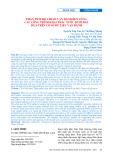

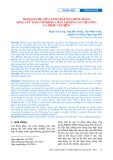

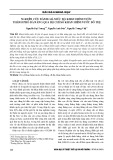
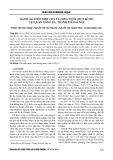

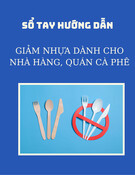
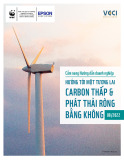
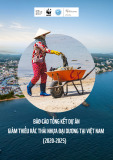
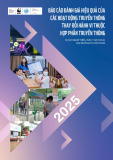
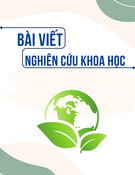




![Ô nhiễm không khí từ nông nghiệp: Thách thức toàn cầu và định hướng hành động [Mới nhất]](https://cdn.tailieu.vn/images/document/thumbnail/2025/20250917/kimphuong1001/135x160/52891758099584.jpg)




